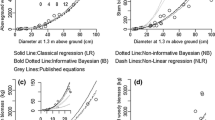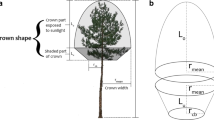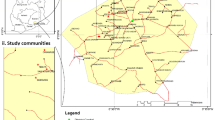Abstract
The aim of this study was to set up allometric models on the development of open-grown trees (OGT) of ash (Fraxinus excelsior L.) and sycamore (Acer pseudoplatanus L.). Sampling was carried out during a study on valuable broadleaves in Europe and covers a geographical location from 0° to 9° eastern longitude and 47° to 51° northern latitude in Western Europe. We set up models describing (I) crown allometry, taking into account possible effects of (II) site-specific differences and (III) species effects. In addition, simulations were used calculating the potential width of the knotty core inside the stem for self-pruned OGTs. The models also procured insight into space occupation of OGTs. This investigation on crown and tree allometry for a broad range of tree size complements dynamic models on growth of broadleaved trees only monitored at young ages and for a small number of years. It quantifies the relationship between tree height, stem diameter, height-stem diameter ratio, height to crown base, and descriptors of crown form. Only for the models on the crown width/length ratio (WL ratio) and on the crown ratio were there no significant allometric differences between the two species. For none of the models were site effects found to be significant. Self-pruning of ash and sycamore OGTs was slow and the simulated knottiness of the trunk was considerable. Therefore artificial pruning is necessary for a long clear bole, although both species are known for fast self-pruning. In addition, comparison of crown allometric models for forest trees and open-grown ash and sycamore trees underlined the need for specific models in agroforestry based on OGT. Specifically, when tree diameter being equal, OGTs have larger crowns compared to trees from closed forests. During tree development crown form changes uniformly with no significant species-related difference: The vertical crown expansion of young ash and sycamore overweighs the lateral expansion. As trees mature, the crown WL ratio increases leading to crown width values almost equal to crown length. Thus in their early stages of development ash and sycamore OGTs invest more in the vertical space occupation and only at later stages in horizontal expansion.



Similar content being viewed by others
References
AK-STOK (1996) Forest site classification. IHW-Verlag, Arbeitskreis Standortskartierung (AK-STOK) in der Arbeitsgemeinschaft Forsteinrichtung, 5th edn. Eching bei München [original in German]
Balandier P (1997) A method to evaluate needs and efficiency of formative pruning of fast-growing broad-leaved trees and results of an annual pruning. Can J For Res 27:809–816
Balandier P, Dupraz C (1999) Growth of widely spaced trees. A case study from young agroforestry plantations in France. Agroforest Syst 43:151–167
Bell S (2008) Valuable broadleaved Trees in the landscape. In: Spiecker H, Hein S, Makkonen-Spiecker K, Thies M (eds) Valuable broadleaved forests in Europe. EFI-Report (in print)
Bella IE (1971) A new competition model for individual trees. For Sci 17:364–372
Blackburn P, Petty JA, Miller KF (1988) The assessment of the static and dynamic factors involved in windthrow. Forestry 61:29–43
Böhlmann D (1970) Die anatomisch-histologische Unterschiede im Verzweigungsbereich zwischen der Fruchtstandsachse und den benachbarten Seitenachsen von Acer platanoides L. und Acer pseudoplatanus L. [Anatomical-histological differences at the branching between seed head axis and neigbouring axis of Acer platanoides L. und Acer pseudoplatanus L.]. Allg Forst Jagd Ztg 141:250–253 [original in German]
Burschel P, Huss J (1997) Grundriss des Waldbaus: ein Leitfaden für Studium und Praxis [Compendium on silviculture: a manual for studying and practice]. Parey-Verlag, Berlin [original in German]
Cabanettes A, Auclair D, Imam W (1999) Diameter and height growth curves for widely-spaced trees in European agroforestry. Agroforest Syst 43:169–181
Cluzeau C (1992) Analyse et modélisation de la croissance et du développement du système aérien du frêne (Fraxinus excelsior L.) en peuplement, en perspective d’applications à la sylviculture [Analysis and modeling of growth and development of the above-ground elements of tree from stands from the viewpoint of application for silviculture]. Dissertation, University Nancy [original in French]
Condés S, Sterba H (2005) Derivation of compatible crown width equations for some important tree species of Spain. For Ecol Manage 217:203–218
Eason WR, Gill EK, Roberts JE (1996) Evaluation of anti-sheep tree-stem-protection products in silvopastoral agroforestry. Agroforest Syst 34:259–264
Franc A, Ruchaud F (1996) Autécologie des feuillus précieux: frêne commun, merisier, érable sycomore, érable plane [Autecology of valuable broadleaves: ash, wild cherry, sycamore]. Etudes Gestion des Territoires 18 [original in French]
Freise C, Spiecker H (1999) Konkurrenzfreies Wachstum der Buche—Wie weit läßt sich das Dickenwachstum durch Kronenexpansion steigern? [Free growth of European beech—how to improve diameter growth through crown expansion]. AFZ-DerWald 54:1346–1349 [original in German]
Gilmore D (2001) Equations to describe crown allometry of larix require local validation. For Ecol Manage 148:109–116
Gordon AM, Newman SM (1997) Temperate agroforestry. CAB International, Wallingford
Grote R, Pretzsch H (2002) A model for individual tree development based on physiological processes. Plant Biol 4:167–180
Haas JN, Rasmussen P (1993) Zur Geschichte der Schneitel- und Laubfutterwirtschaft in der Schweiz - eine alte Landwirtschaftspraxis kurz vor dem Aussterben [On the history of pollarding and leaf forage management in Switzerland—an old agricultural practice prior extinction]. In: Brombacher C, Jacomet S, Haas JN (eds) Festschrift Zoller. Berlin, Stuttgart, pp 469–489 [original in German]
Hasenauer H (1994) Ein Einzelbaumwachstumssimulator für ungleichaltrige Fichten-, Kiefern- und Buchenbestände [A individual tree growth simultor for uneven-aged spruce, pine and beech stands]. Forstliche Schriftenreihe, Universität für Bodenkultur, Wien [original in German]
Hasenauer H (1997) Dimensional relationships of open-grown trees in Austria. For Ecol Manage 96:197–206
Hein S (2003) Zur Steuerung von Astreinigung und Dickenwachstum bei Esche (Fraxinus excelsior L.) und Bergahorn (Acer pseudoplatanus L.) [Controlling natural pruning and diameter growth of ash (Fraxinus excelsior L.) and sycamore (Acer pseudoplatanus L.)]. Dissertation, University Freiburg [original in German]
Hein S, Spiecker H (2007) Comparative analysis of occluded branch characteristics for Fraxinus excelsior and Acer pseudoplatanus with natural and artificial pruning. Can J For Res 37:1414–1426
Hein S, Spiecker H (2008) Controlling diameter growth with ash, sycamore and wild cherry. In: Spiecker H, Hein S, Thies M, Makkonen-Spiecker K (eds) Valuable broadleaved forests in Europe. EFI-Report (in print)
Hemery GE, Savill PS, Pryor SN (2005) Applications of the crown diameter-stem diameter relationship for different species of broadleaved trees. For Ecol Manage 215:285–294
Hislop M, Claridge J (2000) Agroforestry in the UK. Forestry Commission Bulletin 122, Forestry Commission, Edinburgh
Jobling J, Pearce ML (1977) Free growth of Oak. Forestry Commission. HMSO. Forestry Commission Forest Record 113
Kantola A, Mäkelä A (2004) Crown development in Norway Spruce (Picea abies (L.) Karst.). Trees 18:408–421
Kjölby V, Sabroe AS, Moltesen P (1958) AER (Acer pseudoplatanus L.) [sycamore (Acer pseudoplatanus L.)]. Dansk Skovforening [original in Danish]
Kramer H, Saetre OJ, Leonhardt J (1969) Untersuchungen über die Baummerkmale und über den genetischen Einfluss auf das Wachstum bei frei erwachsenen Jungfichten [Analysis of tree attributes and genetic impact on growth of young open-grown Norway Spruce]. Allg Forst Jagd Ztg 141:30–41 [original in German]
Kratochwil A, Schwabe A (1987) Weidbuchen im Schwarzwald als Zeugen extensiver Wirtschaftsweisen: Rekonstruktion von Jugend- und Altersstadien durch aktualistischen Vergleich und Analyse von Stammquerschnitten [Solitary beeches in the black forest as evidence of extensive cattle farming: reconstruction of the early and mature stages by comparison of trees and by the analysis of stem cross-sections.]. Forstwiss Cbl 106:300–311 [original in German]
Kublin E (2003) Einheitliche Beschreibung der Schaftform—Methoden und Programme—BDATPro [A uniform description of stem form—methods and software—BDATPro]. Forstwiss Cbl 122:183–200 [original in German]
Lässig R (1991) Zum Wachstum von Fichtensolitären (Picea abies (L.) Karst.) in Südwestdeutschland [On the growth of open-grown Norway Spruce (Picea abies (L.) Karst.) in Southwest Germany]. Dissertation, University Freiburg [original in German]
Lavny V (2000) Osoblyvosti formuwannja jasenewyh derevostaniw Zahidnogo Lisostepu Ukrainy [On the structure of stands with ash in the Western Forest Steppe of the Ukraine]. Dissertation, Ukrainian State Forest-Technical University, Lviv [original in Ukrainian]
Leech JW (1984) Estimating crown width from diameter at breast height for open-grown radiata pine trees in South Australia. Aust For Res 14:333–337
Machatschek M (2002) Laubgeschichten—Gebrauchsgeschichte einer alten Baumwirtschaft, Speise-und Futterlaubkultur [Stories on leaves—the history of an old tree management system]. Böhlau-Verlag, Wien, Köln, Weimar [original in German]
Mäkinen H, Colin F (1999) Predicting the number, death and self-pruning of Scots pine in Finland. Can J For Res 29:1225–1236
Mancl LA, DeRouen TA (2001) A covariance estimator for GEE with improved small-sample properties. Biometrics 57:126–134
McCullagh P, Nelder JA (1999) Generalized linear models. Chapman & Hall/CRC, Boca Raton
Nagel J (1985) Wachstumsmodell für Bergahorn in Schleswig-Holstein [A growth model for sycamore in Schleswig-Holstein]. Dissertation, University Göttingen [original in German]
Nair PKR (1993) An introduction into agroforestry. Kluwer, Dordrecht
Pretzsch H, Schütze G (2005) Crown allometry and growing space efficiency of Norway Spruce (Picea abies [L.] Karst.) and European beech (Fagus sylvatica L.) in pure and mixed stands. Plant Biol 7:628–639
Rieder A (1998) Ahorn-Wertholzproduktion in kurzen Umtrieben [Producing valuable wood with sycamore in short rotations]. AFZ-DerWald 15:776–779 [original in German]
Roloff A (2001) Baumkronen: Verständnis und praktische Bedeutung eines komplexen Naturphänomens [Tree crowns: comprehension and practical meaning of a complex phenomenon]. Ulmer, Stuttgart [original in German]
Rottmann M (2002) Wind- und Sturmschäden im Wald: Beiträge zur Beurteilung der Bruchgefährdung, zur Schadensvorbeugung und zur Behandlung sturmgeschädigter Nadelholzbestände [Storm- and snow damage in forests: contributions to the evaluation of the risk of breakage, to precluding damage and the treatment of storm-damaged conifer forests] Sauerländer, Frankfurt [original in German]
Rust S, Savill PS (2000) The root system of Fraxinus excelsior and Fagus sylvatica and their competitive relationships. Forestry 73:499–508
Rysavy T (1991) Ursachen der Vereschung - ein Beitrag zu einem vieldiskutierten Phänomen [Causes of overdominance of ash—a contribution to a widely discussed phenomenon]. Forstarchiv 62:184–188 [original in German]
SAS (2005) The GLIMMIX procedure. SAS Publishing, Cary
SAS 9.1 (2004) SAS/STAT 9.1 user’s guide. SAS Publishing, Cary
Sibbald AR, Eason WR, McAdam JH, Hislop AM (2001) The establishment phase of a Silvopastoral National Network experiment in the UK. Agroforest Syst 39:39–53
Soulères G (1997) Les feuillus précieux—les prix des bois sur pied et leur évolution 1955–1995 [Valuable broadleaves—round wood prices and their evolution 1955–1995]. Forets France 404:2–8 [original in French]
Spiecker H (1991) Zur Steuerung des Dickenwachstums und der Astreinigung von Trauben- und Stieleichen (Quercus petrea (Matt.) Liebl. und Quercus robur L.) [On the controlling of diameter growth and natural pruning of Sessile and Pedunculate Oak (Quercus petrea (Matt.) Liebl. and Quercus robur L.)]. Schriftenreihe der Landesforstverwaltung Baden-Württemberg 72. Stuttgart [original in German]
Teklehaimanot Z, Jones M, Sinclair FL (2002) Tree and livestock productivity in relation to tree planting configuration in a silvopastoral system in North Wales, UK. Agroforest Syst 56:47–55
Vanck T, Spiecker H (2004) Rekonstruktion der Kronenentwicklung von Mittelwaldbuchen [Reconstruction of crown development of beech from coppice with standard stands]. Allg Forst Jagd Ztg 175:182–188 [original in German]
Vestøl GI, Colin F, Loubère M (1999) Influence of progeny and initial stand density on the relationship between diameter at breast height and knot diameter of Picea abies. Scand J For Res 14:470–480
Wairiu M, Mullins CE, Campell CD (1993) Soil physical factors affecting the growth of sycamore (Acer pseudoplatanus L.) in a Silvopastoral system on a stony upland soil in North-East Scotland. Agroforest Syst 24:295–306
Weber G (1998) Wachstum und Ernährungszustand von jungen Eschen (Fraxinus excelsior L.) und Bergahornen (Acer pseudoplatanus L.) in Abhängigkeit von der Basen- und Al-Sättigung und vom Wasserhaushalt natürlicher Böden [Growth and nutritional status of young ash (Fraxinus excelsior L.) and sycamore (Acer pseudoplatanus L.) depending on bases- and AL-saturation and water supply of natural soils]. Hieronymus Verlag, München [original in German]
Whiteman A, Insley H, Watt G (1991) Price-size curves for broadleaves. Forestry Commission Occasional Paper 32. Edinburgh
Zeng B, Agresti A (2000) Summarizing the predictive power of a generalized linear model. Stat Med 19:1771–1781
Acknowledgements
We thank the European Forest Institute (EFI, Joensuu/Finland) for financing the project “Management of Mixed Broadleaved Forests in Europe” (Project No. 92/ 8553 EFI) and Robin Hillestad MSc as well as Ginamarie Lopez for revising the language.
Author information
Authors and Affiliations
Corresponding author
Rights and permissions
About this article
Cite this article
Hein, S., Spiecker, H. Crown and tree allometry of open-grown ash (Fraxinus excelsior L.) and sycamore (Acer pseudoplatanus L.). Agroforest Syst 73, 205–218 (2008). https://doi.org/10.1007/s10457-008-9145-2
Received:
Accepted:
Published:
Issue Date:
DOI: https://doi.org/10.1007/s10457-008-9145-2




